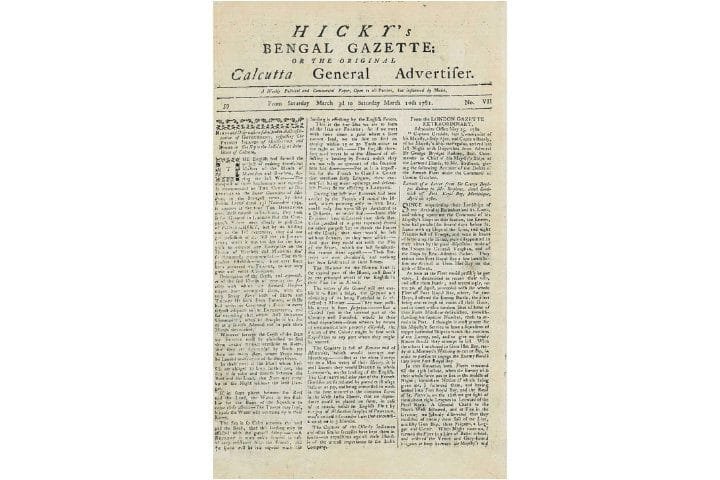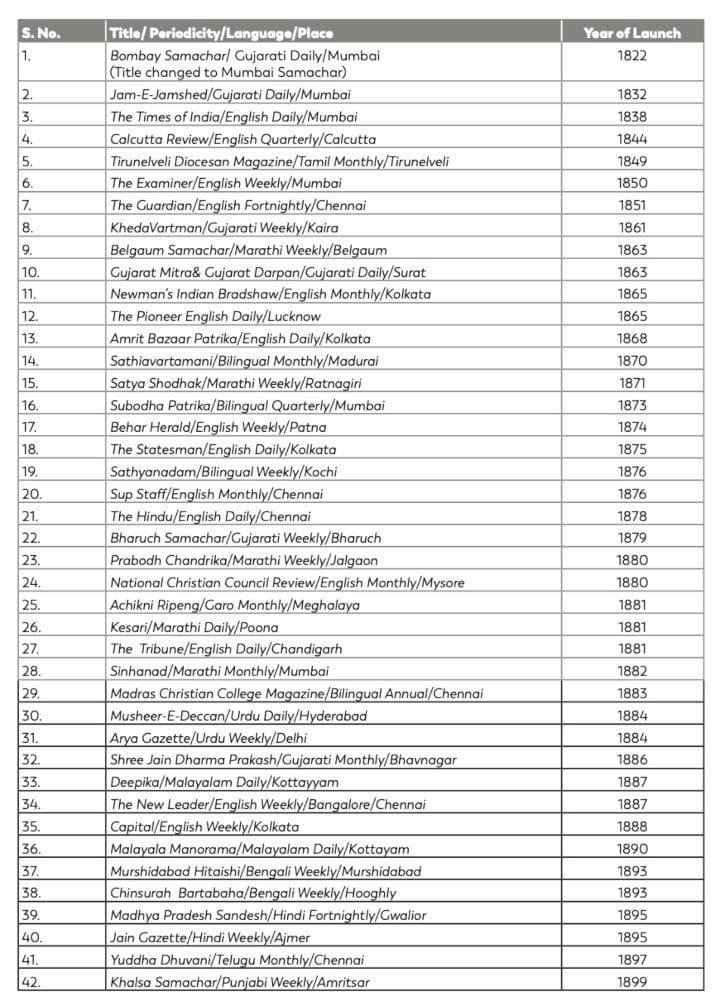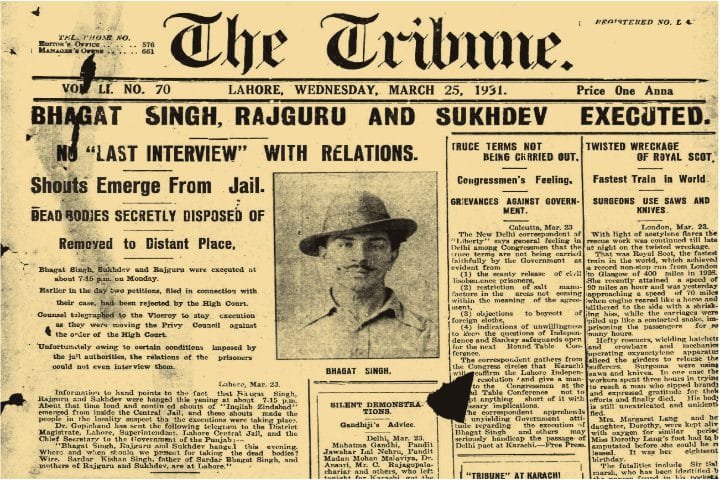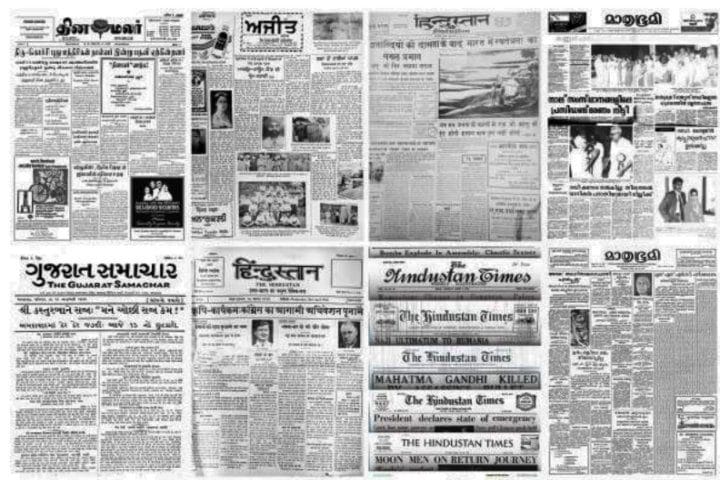Language Press in India
The press in India has significantly influenced public opinion and directed the collective energy of the populace during the nation’s fight for independence. Print media was crucial in supporting democracy and nation-building immediately after independence. After independence, the Government of India established the First Press Commission under Justice G.S. Rajadhyaksha in 1952 to promote the development and growth of the press in the country, which has expanded in all dimensions since then.
The Office of the Registrar of Newspapers for India was established based on the First Press Commission’s recommendations. Its 1954 report to the Government of India suggested creating a statutory authority to collect reliable statistics about the press in India.
The government, following the recommendation of the First Press Commission, amended the Press & Registration of Books Act, leading to the establishment of the Registrar of Newspapers for India (RNI) under Section 19(A) of the amended Act, effective from 01.07.1956.
The Jan Vishwas (Amendment of Provisions) Act, 2023, has amended the Press & Registration of Books (PRB) Act of 1867. The 1867 Act included sections with imprisonment and fines decriminalized by the 2023 Act.
The India Parliament passed the Press and Registration of Periodicals Act of 2023 to streamline the title allotment and registration process for periodicals through an online system, eliminating the need for face-to-face interaction.
RNI Registration

Newspaper registration occurs in two steps. The intending publisher must apply to the District Magistrate’s office for title verification using the prescribed format. The DM authenticates the application and forwards it to RNI for title verification. Following title verification, the publisher and/or printer must submit a declaration (Form I) to the relevant DM office.
Once the declaration is authenticated, the periodical’s Volume I, Issue I, will be published within the set timeframe. The publisher must submit the necessary documents to the RNI office to obtain the registration certificate. After examining the data of the previously verified titles, RNI verifies the title that the concerned DM has forwarded.
The press in India includes publications in various languages. The Annual Report of the Registrar of Newspapers for India (RNI), titled “Press in India,” for the year 2022-23, indicates that publications were released in 51 languages and dialects across India.
The Hindi press continued to hold its prominent position in the Indian press landscape. According to information gathered from publishers’ Annual Statements for the years 2022–2023, Hindi (16,782) had the most periodicals, followed by Marathi (2,753), English (2,443), Telugu (2,279), Gujarati (2,019), Urdu (1,705), Kannada (1,336), Tamil (874), Bengali (536), Odia (426), and Malayalam (340), among others. Indian languages have been confirmed to dominate the English press in both circulation and numbers.
In terms of circulation, Hindi periodicals continued to lead with 19,96,36,883 copies, followed by English (3,93,11,277), Marathi (3,66,90,734), Urdu (2,46,78,971), Telugu (2,13,05,637), Gujarati (1,71,57,174), and Malayalam (1,08,34,051).
History of Language Press in India
The development of printing technology and the onset of British colonial rule coincided with the late 18th century, which is when the language press in India first appeared.

James Augustus Hicky published the “Bengal Gazette,” also called the “Calcutta General Advertiser,” a weekly English-language newspaper produced in Calcutta, the capital of British India.
The Serampore Mission Press launched the Bengali weekly “Samachar Darpan” on May 23, 1818, marking it the first newspaper in the Indian language. This was the start of vernacular journalism in India. Shortly after, other language newspapers appeared:
- The first Gujrati language newspaper: “Bombay Samachar” (1822), still being published today. (The title has now been changed to Mumbai Samachar.)
- The first Hindi-language newspaper: “Samachar Sudha Varshan” (1854)
- The first Marathi language newspaper: “Darpan” (1832)
- The first monthly Tamil journal: “Tamil Patrika” (1831)
- The first Malayalam journal published in Kerala: “Rajya Samacharam” (1847)
- The first known Urdu-language newspaper: “Jam-i-Jahan Numa” (1822)
Major Landmarks in Language Press in India

The growth of the language press in India was initially slow due to factors such as low literacy rates, limited printing facilities, and restrictive colonial policies. However, the Indian press gained momentum during the 19th century, particularly after the 1857 Revolt, as it became a platform for expressing nationalist sentiments and social reform ideas.
Newspapers significantly influenced public opinion, encouraged national identity, and supported regional languages and cultures.
The British colonial government, cautious of the increasing impact of vernacular newspapers, implemented a range of restrictive measures:
- The Censorship of Press Act (1799) empowered the government of British India to regulate and restrict the content found in newspapers and publications.
- Governor General John Adams enacted the License Regulations of 1823 to regulate the media landscape in India. The act made publishing without a license from the Governor-General in Council illegal, except for shipping intelligence.
- The Vernacular Press Act of 1878 was controversial legislation introduced in India during British colonial rule. The legislation was enacted to restrict the liberties of the Indian press and prevent them from expressing criticism towards the British Government.
Despite these challenges, the language press flourished, playing a significant role in the Indian independence movement and social reform initiatives.
Growth of Language Press in India
The growth of language press in India can be attributed to several factors:
Increase in literacy rates: As literacy rates improved, especially post-independence, the demand for vernacular newspapers increased significantly.
Technological advancements: The introduction of offset printing and computerization in the 1980s and 1990s made newspaper production more efficient and cost-effective.
Economic liberalization: The economic reforms of 1991 led to increased advertising revenues, enabling newspapers to expand their operations.
Political awareness: Growing political consciousness among the masses created a demand for news and information in regional languages.
Cultural identity: Language newspapers preserved and promoted regional languages and cultures.
The growth of language press can be observed through the following trends:
Increase in circulation: Hindi newspapers like Dainik Jagran and Dainik Bhaskar have surpassed English dailies in circulation.
Multiple editions: Major language newspapers now publish multiple editions from different cities and towns.
Diversification: Many language newspapers have expanded into digital platforms, radio, and television.
English Language Press in India

It’s important to note the role of the English language press in India. English newspapers have traditionally catered to urban, educated readers and significantly influenced policy-making circles. Despite the growth of the language press, English newspapers continue to hold a substantial market share, especially in metropolitan areas.
The first English newspaper in India was “Hicky’s Bengal Gazette” (1780).
Major English newspapers include The Times of India, Hindustan Times, and The Hindu. In 2022–23, in the English language, 12,550 periodicals were brought out from the thirteen metropolitan cities. The total circulation of English-language periodicals was 3,93,11,277 copies per publishing day.
Future of Language Press in India

Given the influence of various trends and factors, the language press in India appears to have a bright future.
Digital transformation: Language newspapers adopt digital platforms to engage younger readers and compete with online news sources.
Hyperlocal focus: Many language newspapers focus on hyperlocal content to maintain relevance and connect with local communities.
Multimedia integration: Newspapers explore multimedia content, including videos and podcasts, to enhance reader engagement.
Data-driven journalism: Incorporation of data analytics to understand reader preferences and tailor content accordingly.
Vernacular digital growth: The increasing penetration of smartphones and internet connectivity in rural areas is expected to drive the growth of vernacular digital news platforms.
Challenges from social media: Language newspapers must adapt to the changing news consumption patterns influenced by social media platforms.
Revenue diversification: Exploring new revenue streams beyond traditional advertising, such as events, e-commerce, and subscription-based models, is also important for the sustainable growth of language publications.
Conclusion
The language press in India has come a long way since its inception in the early 19th century. It has played a crucial role in shaping public opinion, promoting regional languages and cultures, and contributing to the nation’s socio-political discourse. The language press in India thrives despite challenges from digital media and changing reader preferences, adapting to new technologies, and evolving expectations.
The future of language press in India looks promising, with vernacular newspapers expected to drive growth in the print media sector. To stay relevant and competitive, language newspapers must adopt digital transformation, prioritize quality journalism, and investigate new business models.
India’s linguistic diversity is a key feature of its media landscape. The language press in India will be crucial in shaping the nation’s future, bridging the urban-rural divide, and representing diverse regional perspectives.




